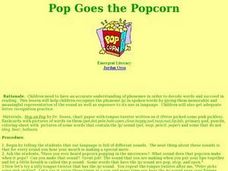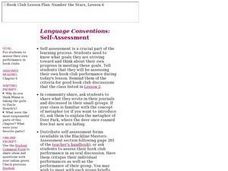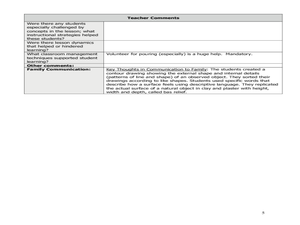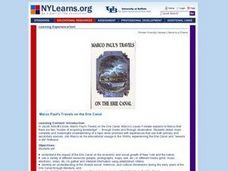Curated OER
Treasure Hunt
Students find lost "treasure" using a treasure map after being shown a map that you have created where terms and symbols are discussed. The class is divided into small groups where they locate your treasure and then read a section from...
Curated OER
Fractions
Fourth graders define and identify fractions. They draw a fraction with the correct number of equal parts, shade a specified number of parts, and write a fraction based on information from a variety of story problems. Students observe...
Curated OER
Lobster Business Charts
Young scholars research four Maine based businesses involved with lobster fishery as a career analysis. For this career exploration lesson, students research lobster fishery businesses and write a class book showing the progression of a...
Curated OER
POP! Goes the Popcorn!
Students complete a variety of activities based on examining corn and popcorn as one of the major crops of Kansas. They journal the results of the multidisciplinary activities in this unit.
Curated OER
Ceramics: A Vessel Into History
Students evaluate the work of their peers using the criteria for value and meaning they developed. In this ceramics lesson, students evaluate their peers’ vessels in their journals by responding to the given questions about the art...
Curated OER
Ceramics: A Vessel into History
High schoolers evaluate the works of their peers using criteria for value and meaning.
Curated OER
Still-Life Painting: Arranging Nature
High schoolers display the two still-life paintings that they created in previous lessons, along with their artist's statements. They write a review of a peer's work and discuss all of the paintings in a group critique.
Curated OER
The Role of International Organizations in Peacekeeping
Eighth graders are given two case studies. They determine if the United Nations should become involved, and if so, in what capacity? students explain their decisions based on a set of criteria determined by the class.
Curated OER
Shaping Ideas: Symbolism in Sculpture
High schoolers participate in a class critique of the symbolic sculptures they created. They critique the work of their peers by responding to questions about the symbolic content and applying criteria for sculpture.
Curated OER
Issues Close to Home
Students discuss their role in their local government. Individually, they use various types of media to examine and take a position on a topic important to them. To introduce their position, they write a letter to the Board of...
Curated OER
Language Conventions:
Students assess their own book club performance during today's lesson. They share what they wrote in their journals and discussed in their small groups. They critique their individual performances as well as the performance of their group.
Curated OER
Reel or Real?
Students compare and contrast a live versus an animated performance of the same title. They view and take notes during the animated version, take a field trip to observe the live version, and write an opinion on which performance is most...
Curated OER
Rearrange the Room
Second graders measure and grid their ideas for the new classroom floor plan. They create their own ideas for the classroom arrangement on grid paper. When they finish, they share their draft plan with their peers and with the teacher...
Curated OER
Finding Information Within a Newspaper
Fifth graders find information within a newspaper in this activity. They use a question worksheet to locate particular pieces of information. They completely and accurately write the section letters and page numbers in order to answer...
Curated OER
Nest Construction and Area Management Activities
Students construct a nest for a fictitious ground-nesting bird.They create models of the bird (along with its eggs) that might theoretically live in this habitat. They write in a daily journal about what happens to their nests in a...
Curated OER
What's Standing in Your Way?
Students explore forces that hinder and help them achieve their goals. In this language arts lesson, students brainstorm ways in which they can address the forces that hinder and help. Students write in their journals. Students address...
Curated OER
Plaster Casts of Natural Objects
Fourth graders observe objects in science and create a contour picture of the the object. In this arts and science observation instructional activity, 4th graders develop a clay sculpture of their object. Students generate a list of...
Curated OER
Level Two ITIP (DM)
Students, while working in groups, recognize how to use a decision making process to make positive and healthy decisions concerning health issues. They brainstorm reasons for choosing drugs, witness a decision making power point and...
J. Paul Getty Trust
Shaping Ideas: Symbolism in Sculpture—Lesson 3
The final session in a sequential, three-lesson sculpture study designed by the education staff of the J. Paul Getty Museum in Los Angeles has class members using the criterial they developed to critique each others' symbolic sculptures.
Curated OER
Pirates: Fact or Fiction?
Students gain an understanding of what pirates are and to prove they really did and do exist. They discuss the different myths the students have about pirates as compared to what the documentary discusses.
Curated OER
Conflicts of Current Interest
Students use conflicts in the Middle East to explore tactics of conflict resolution.
Curated OER
Cancer: A Crisis of the Cells
Pupils analyze cancer data represented in graphs and charts. They describe the changes in cell structure and function as the result of cancer. They also examine phenomenas that are believed to cause cancer.
Curated OER
Match Shapes in Compositions
Third graders draw shapes that are congruent with each other and identify other congruent shapes. In this congruency lesson plan, 3rd graders also apply specific colors from the color wheel in their shapes.
Curated OER
Marco Paul's Travels on the Erie Canal
Students conduct research in order to create an understanding of The Eerie Canal and its place in history and the world. students use a variety of primary and secondary resources to aid in the research process.

























